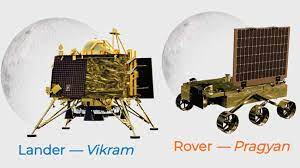NEW DELHI, Sept 21: With dawn breaking back on the Moon, Indian Space Research Organisation (ISRO) is now gearing up to try to re-establish communication with its lunar mission Chandrayaan-3’s solar-powered lander Vikram and rover Pragyan to revive them so that they can continue with scientific experiments.
Both the lander and the rover were put into sleep mode earlier this month on September 4 and 2 respectively, ahead of the lunar night setting in on moon. So, if ISRO is able to revive them as the Sun rises on the Moon again, information that is derived from experiments that could once again be conducted by the Chandrayaan-3 payloads would be a “bonus.”
With sunlight back on the south polar region of the Moon, where both the lander and rover are located, and their solar panels expected to be optimally charged soon, ISRO is now slated to make efforts to establish contact with them again, check their health and ability to resume functioning, and try to revive them.
“We have put both the lander and rover on sleep mode because temperature would go as low as minus 120-200 degree Celsius. From September 20 onwards, sunrise will be going on at the Moon and by September 22 we hope that the solar panel and other things will be fully charged, so we will be trying to revive both the lander and rover, “ISRO’s Space Applications Centre Director Nilesh Desai said.
“If our luck is good, we will have revival of both lander and rover and we will get some more experimental data, which will be useful for us to further do investigation of the Moon’s surface. We are eagerly waiting for activity from September 22 onwards. We hope that we are lucky enough to revive both lander and rover and get some more useful data,” he said, adding that whatever data they get hereon would be a bonus.
After landing on the Moon, both the lander and the rover, and payloads onboard had performed experiments one after the other so as to complete them within 14 Earth days (one lunar day), before pitch darkness and extreme cold weather engulfed the Moon.
The lander and rover — with a total mass of 1,752 kg — were designed to operate for one lunar daylight period (about 14 Earth days) to study the surroundings there. However ISRO is hoping that they will come back to life when the Sun again rises on the Moon, and carry on with the experiments and studies there.
(Manas Dasgupta)

